Photocatalytic Self-Cleaning Cotton Fabrics Coated by Cu2(OH)PO4 under VIS/NIR Irradiation
Abstract
1. Introduction
2. Experimental
2.1. Materials and Reagents
2.2. Methods
2.2.1. Preparation of Cu2(OH)PO4 Photocatalyst
2.2.2. Fabrication of Cu2(OH)PO4 Photocatalyst-Coated Cotton Fabrics
2.3. Materials Characterization
2.4. Photocatalytic Activity
2.5. Self-Cleaning Property
3. Results and Discussion
3.1. Raman and FTIR Analysis
3.2. X-ray Diffraction (XRD) Analysis
3.3. Scanning Electron Microscopy (SEM) Images and Energy Dispersive Spectroscopy (EDS) Analysis
3.4. X-ray Photoelectron Spectroscopy (XPS) Analysis
3.5. UV–VIS–NIR Diffuse Reflectance Spectroscopy
3.6. Photocatalytic Performance
3.7. Thermogravimetric Analysis (TGA) Analysis
3.8. Self-Cleaning Properties
4. Conclusions
Supplementary Materials
Author Contributions
Funding
Acknowledgments
Conflicts of Interest
References
- Ibrahim, N.A.; Eid, B.M.; Khalil, H.M.; Alsaid, A.A. A new approach for durable multifunctional coating of PET fabric. Appl. Surf. Sci. 2018, 448, 95–103. [Google Scholar] [CrossRef]
- Mahdieh, Z.M.; Shekarriz, S.; Taromi, F.A.; Majid, M. A new method for in situ synthesis of Ag-TiO2, nanocomposite particles on polyester/cellulose fabric by photoreduction and self-cleaning properties. Cellulose 2018, 25, 2355–2366. [Google Scholar] [CrossRef]
- Mahoney, L.; Koodali, R.T. Versatility of evaporation-induced self-assembly (EISA) method for preparation of mesoporous TiO2 for energy and environmental applications. Materials 2014, 7, 2697–2745. [Google Scholar] [CrossRef] [PubMed]
- Zhu, C.; Shi, J.; Xu, S.; Ishimori, M.; Sui, J.; Morikawa, H. Design and characterization of self-cleaning cotton fabrics exploiting zinc oxide nanoparticle-triggered photocatalytic degradation. Cellulose 2017, 24, 2657–2667. [Google Scholar] [CrossRef]
- Fan, Y.; Zhou, J.; Zhang, J.; Lou, Y.; Huang, Z.; Ye, Y.; Jia, L.; Tang, B. Photocatalysis and self-cleaning from g-C3N4, coated cotton fabrics under sunlight irradiation. Chem. Phys. Lett. 2018, 699, 146–154. [Google Scholar]
- Du, Z.; Cheng, C.; Tan, L.; Lan, J.; Jiang, S.; Zhao, L.; Guo, R. Enhanced photocatalytic activity of Bi2WO6/TiO2, composite coated polyester fabric under visible light irradiation. Appl. Surf. Sci. 2018, 435, 626–634. [Google Scholar] [CrossRef]
- Tsuji, M.; Matsuda, K.; Tanaka, M.; Kuboyama, S.; Uto, K.; Wada, N.; Kawazumi, H.; Tsuji, T.; Ago, H.; Hayashi, J. Enhanced photocatalytic degradation of methyl orange by Au/TiO2 nanoparticles under neutral and acidic solutions. Chem. Select. 2018, 3, 1432–1438. [Google Scholar] [CrossRef]
- Chen, Z.; Yang, J.; Yang, X.; Zhao, Y.; Kang, J.; Yang, F.; Zhang, Y.; Cheng, M.; Wang, G.; Duanmu, Q. Porous Si/TiO2 Nanowire photoanode for photoelectric catalysis under simulated solar light irradiation. Appl. Organomet. Chem. 2018, 32, e4356. [Google Scholar] [CrossRef]
- Gong, C.; Du, J.; Li, X.; Gong, C.; Du, J.; Li, X.; Yu, Z.; Ma, J.; Qi, W.; Zhang, K.; Yang, J.; Luo, M.; Peng, H. One-step Acidic hydrothermal preparation of dendritic rutile TiO2 nanorods for photocatalytic performance. Nanomaterials 2018, 8, 683. [Google Scholar] [CrossRef]
- Ghosh, M.; Liu, J.; Chuang, S.S.C.; Jana, S.C. Fabrication of hierarchical V2O5 nanorods on TiO2 nanofibers and their enhanced photocatalytic activity under visible light. ChemCatChem 2018, 10, 3305–3318. [Google Scholar] [CrossRef]
- Wang, G.; Huang, B.; Ma, X.; Wang, Z.; Qin, X.; Zhang, X.; Dai, Y.; Whangbo, M. Cu2(OH)PO2, a near-infrared-activated photocatalyst. Angewandte Chemie. 2013, 52, 4810–4813. [Google Scholar] [CrossRef] [PubMed]
- Wang, G.; Huang, B.; Li, Z.; Wang, Z.; Qin, X.; Zhang, X.; Dai, Y.; Whangbo, M. On structural features necessary for near-IR-light photocatalysts. Chemistry 1358, 21, 13583. [Google Scholar] [CrossRef] [PubMed]
- Shah, S.S.; Karthik, S.; Singh, N.D.P. Vis/NIR light driven mild and clean synthesis of disulfides in the presence of Cu2(OH)PO4 under aerobic conditions. Rsc Adv. 2015, 5, 45416–45419. [Google Scholar] [CrossRef]
- Liu, G.; Zhou, Y.; Teng, J.; Zhang, J.; You, S. Visible-light-driven photocatalytic activation of peroxymonosulfate by Cu2(OH)PO4 for effective decontamination. Chemosphere 2018, 201, 197–205. [Google Scholar] [CrossRef] [PubMed]
- Mosleh, S.; Rahimi, M.R. Intensification of abamectin pesticide degradation using the combination of ultrasonic cavitation and visible-light driven photocatalytic process: Synergistic effect and optimization study. Ultrason. Sonochem. 2017, 35, 449–457. [Google Scholar] [CrossRef] [PubMed]
- Wang, N.H.; Zhu, X.; Zhang, R.; Wang, Y.; Huang, G.; Zhang, Z. Synthesis of anti-aggregation silver nanoparticles based on inositol hexakisphosphoric micelles for a stable surface enhanced Raman scattering substrate. Nanotechnology 2009, 20, 315603–315609. [Google Scholar] [CrossRef] [PubMed]
- Xu, Y.; Jiao, X.; Chen, D. Hydrothermal synthesis and characterization of copper hydroxyphosphate hierarchical superstructures. J. Disper. Sci. Technol. 2011, 32, 591–595. [Google Scholar] [CrossRef]
- Zhou, W.; Zhang, Y.; Shi, Y. In-situ loading TiO2 and its photocatalysis and UV resistance on cotton fabric. Fiber. Polym. 2017, 18, 1073–1078. [Google Scholar] [CrossRef]
- Li, Y.; Liu, X.; Qian, Y.; Cao, S.; Yang, X.; Chu, Z. Preparation and property of functionalized bacterial cellulose composite. New Chem. Mat. 2017, 45, 247–249. [Google Scholar]
- Thi, V.H.T.; Lee, B.K. Development of multifunctional self-cleaning and UV blocking cotton fabric with modification of photoactive ZnO coating via microwave method. J. Photoch. Photobiolo. A 2017, 338, 13–22. [Google Scholar]
- Hunt, G.R.; Salisbury, J.W.; Lenhoff, C. Visible and near-infrared spectra of minerals and rocks III: Oxides and hydroxides. Modern Geol. 1971, 2, 195–205. [Google Scholar]
- Thommes, M.; Kaneko, K.; Neimark, A.V.; Oliver, J.P.; Rodriguez-Reinoso, F.; Rouquerol, J.; Sing, K.S.W. Physisorption of gases, with special reference to the evaluation of surface area and pore size distribution (IUPAC Technical Report). Pure Appl. Chem. 2015, 87, 1051–1069. [Google Scholar] [CrossRef]
- Rouquerol, F.; Sing, K. Absorption by Powders and Porous Solids: Principles, Methodology and Applications; Academic Press: New York, NY, USA, 1999. [Google Scholar]
- Lowell, S.; Shields, J.E.; Thomas, M.A.; Thommes, M. Characterization of Porous Solids and Powders: Surface Area, Pore Size and Density; Springer Science & Business Media: Boynton Beach, FL, USA, 2012. [Google Scholar]
- Subbiah, D.K.; Mani, G.K.; Babu, K.J.; John, A.D.; Rayappan, B.B. Nanostructured ZnO on cotton fabrics-A novel flexible gas sensor & UV filter. J. Clean. Prod. 2018, 194, 372–382. [Google Scholar]

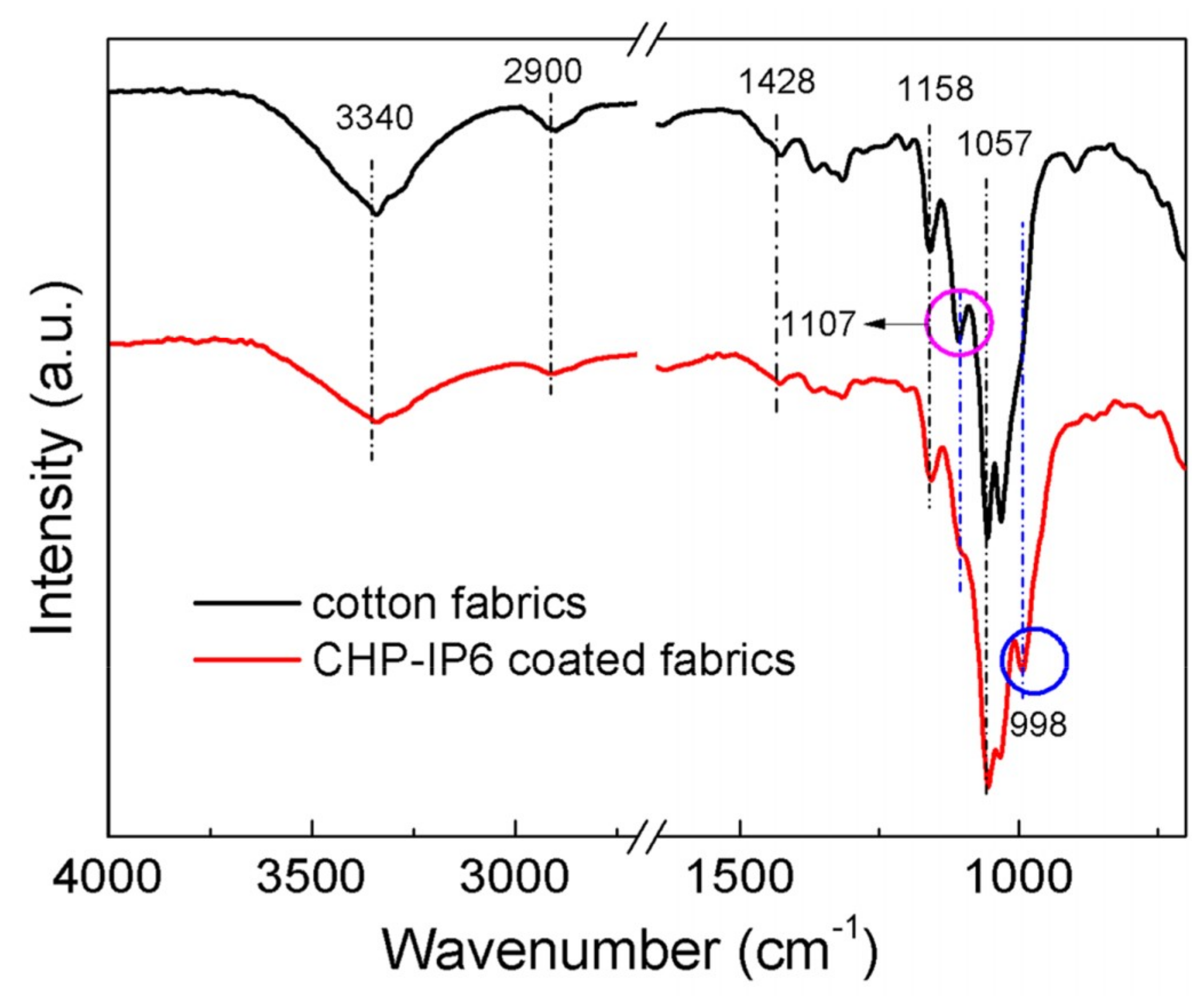

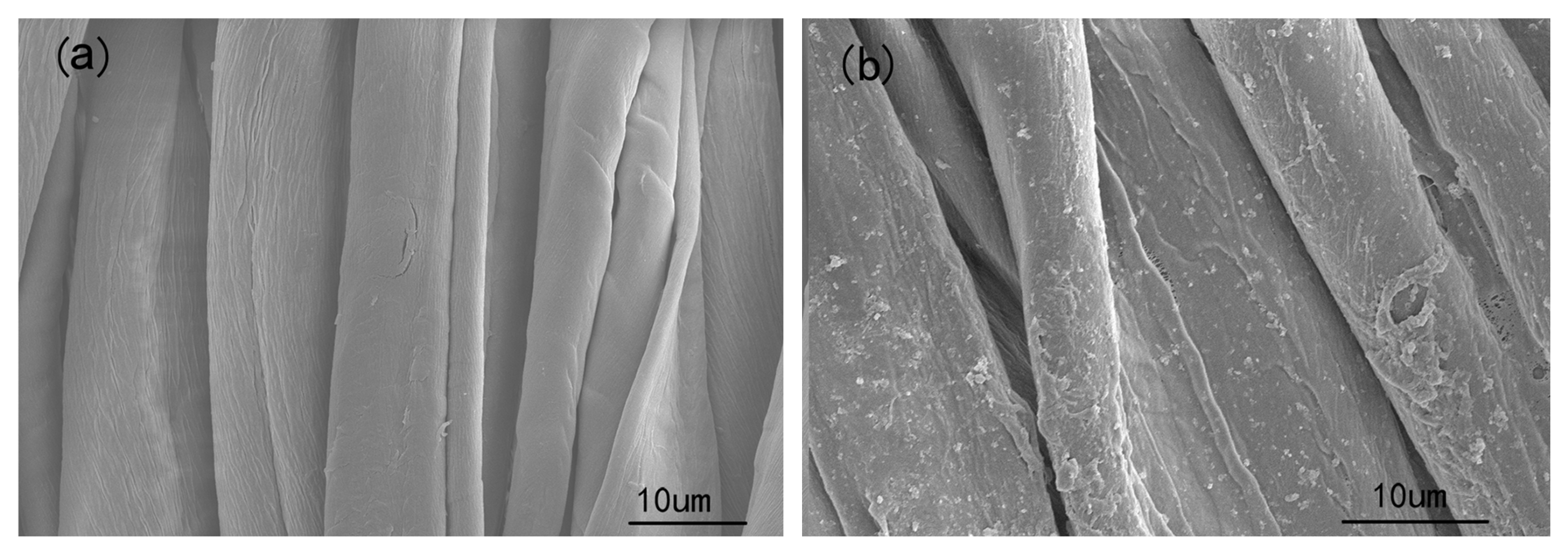
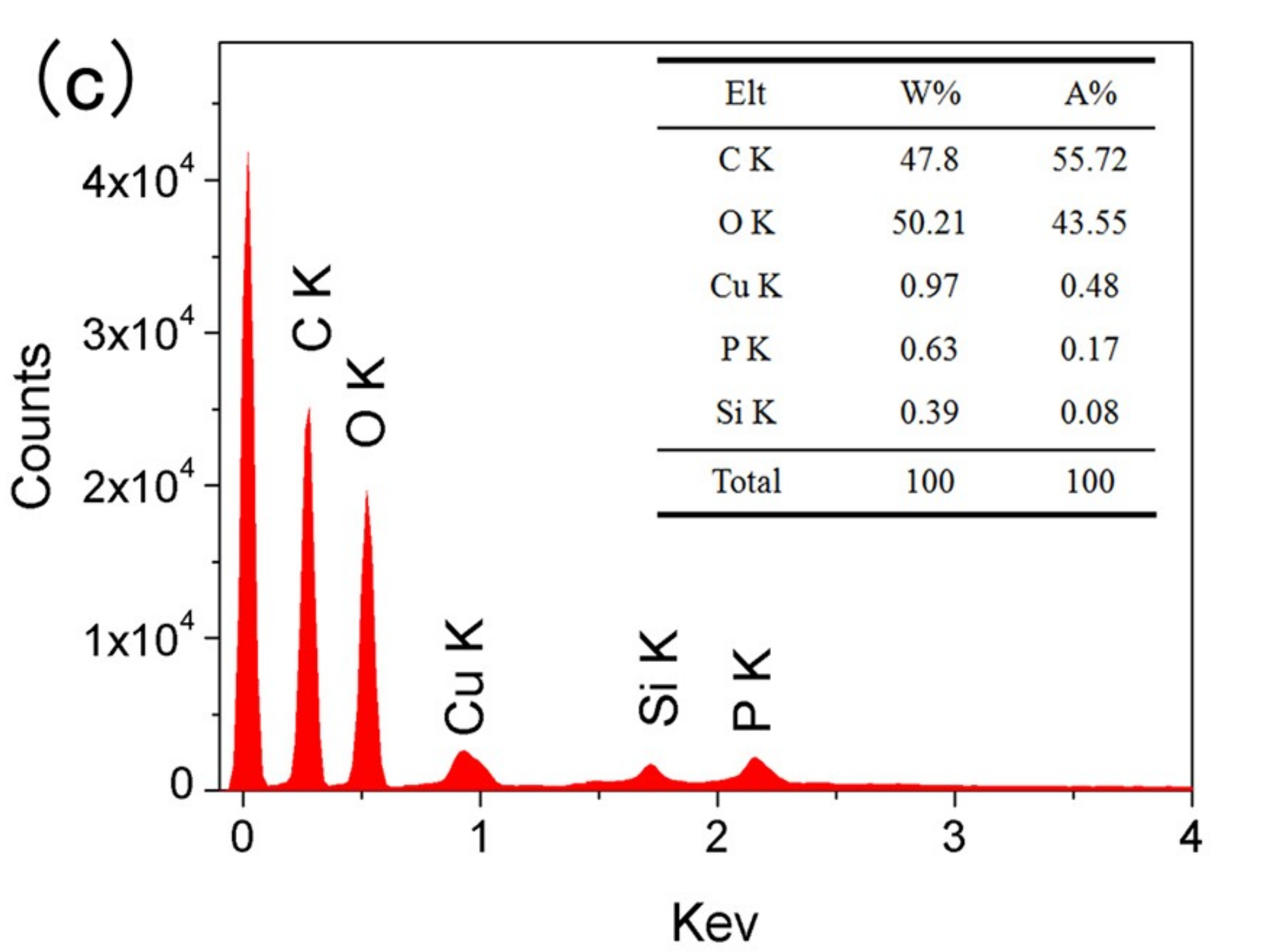
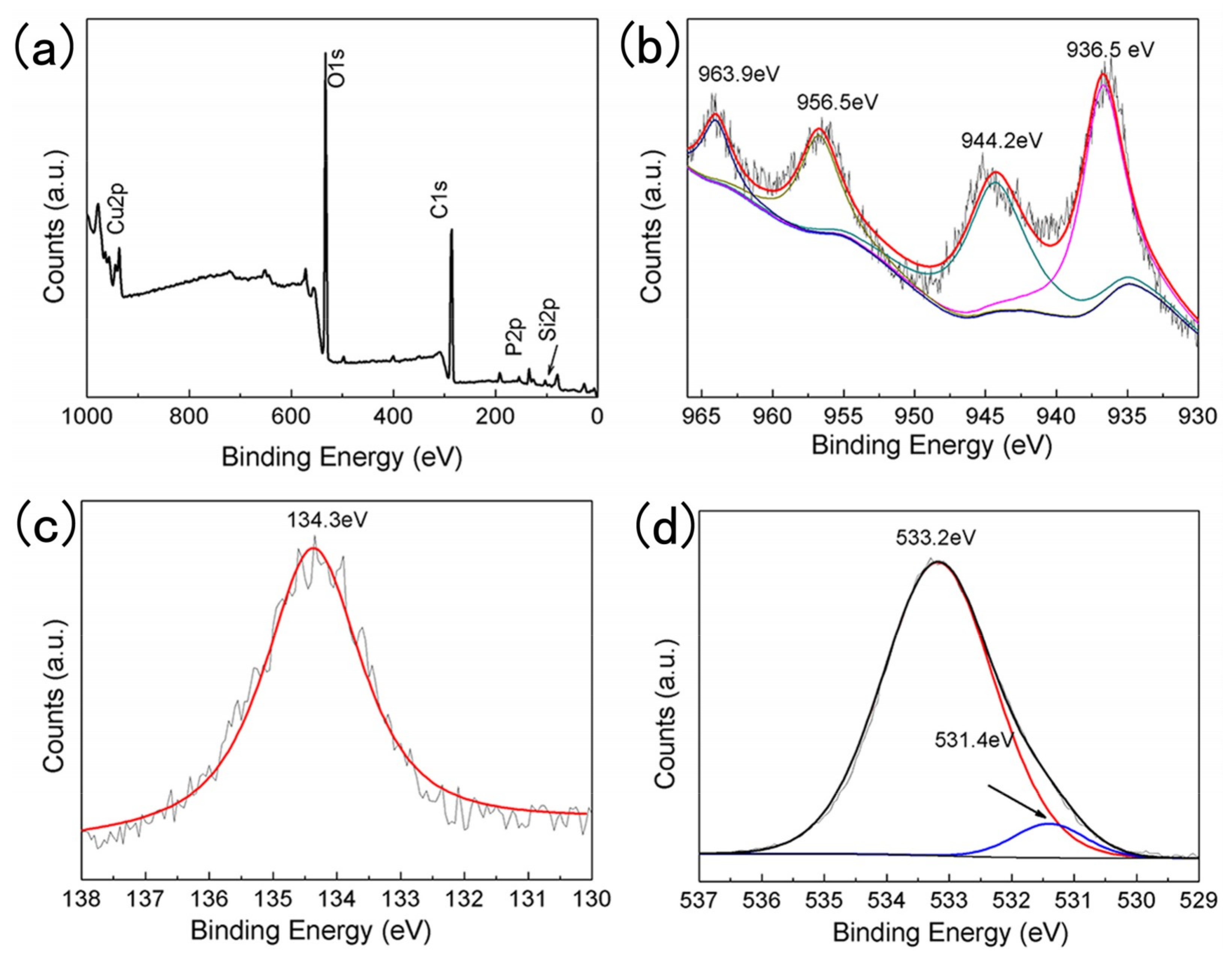
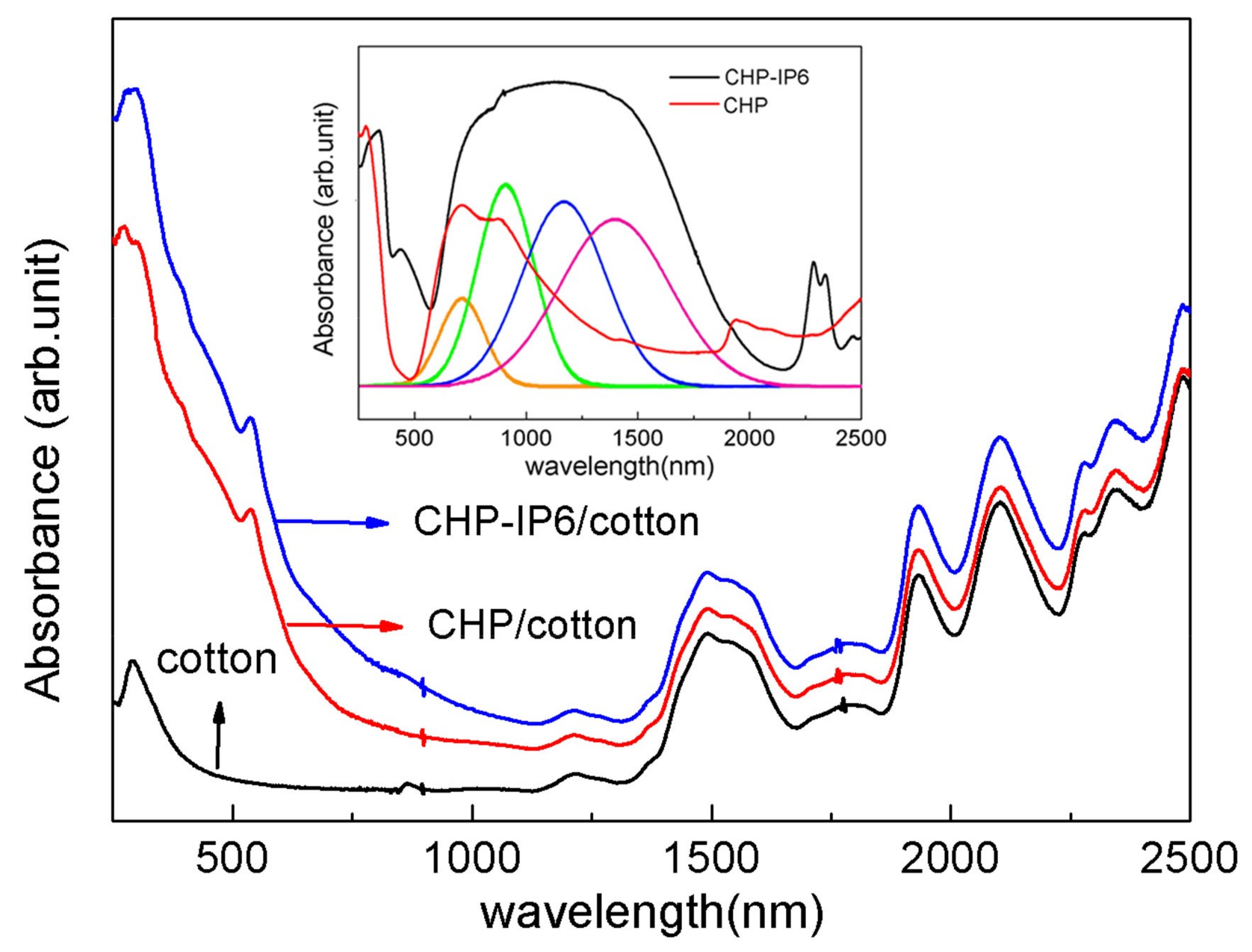

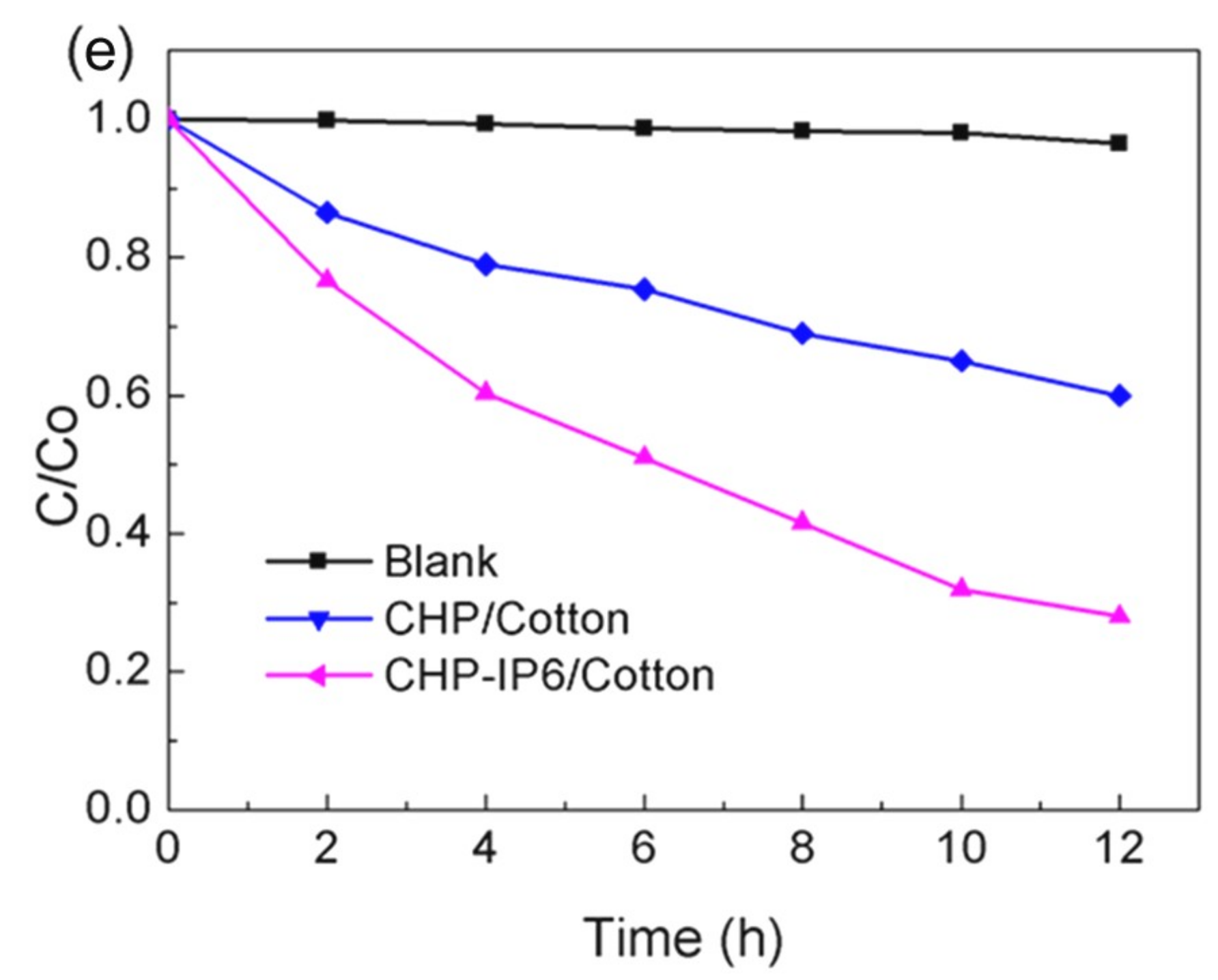
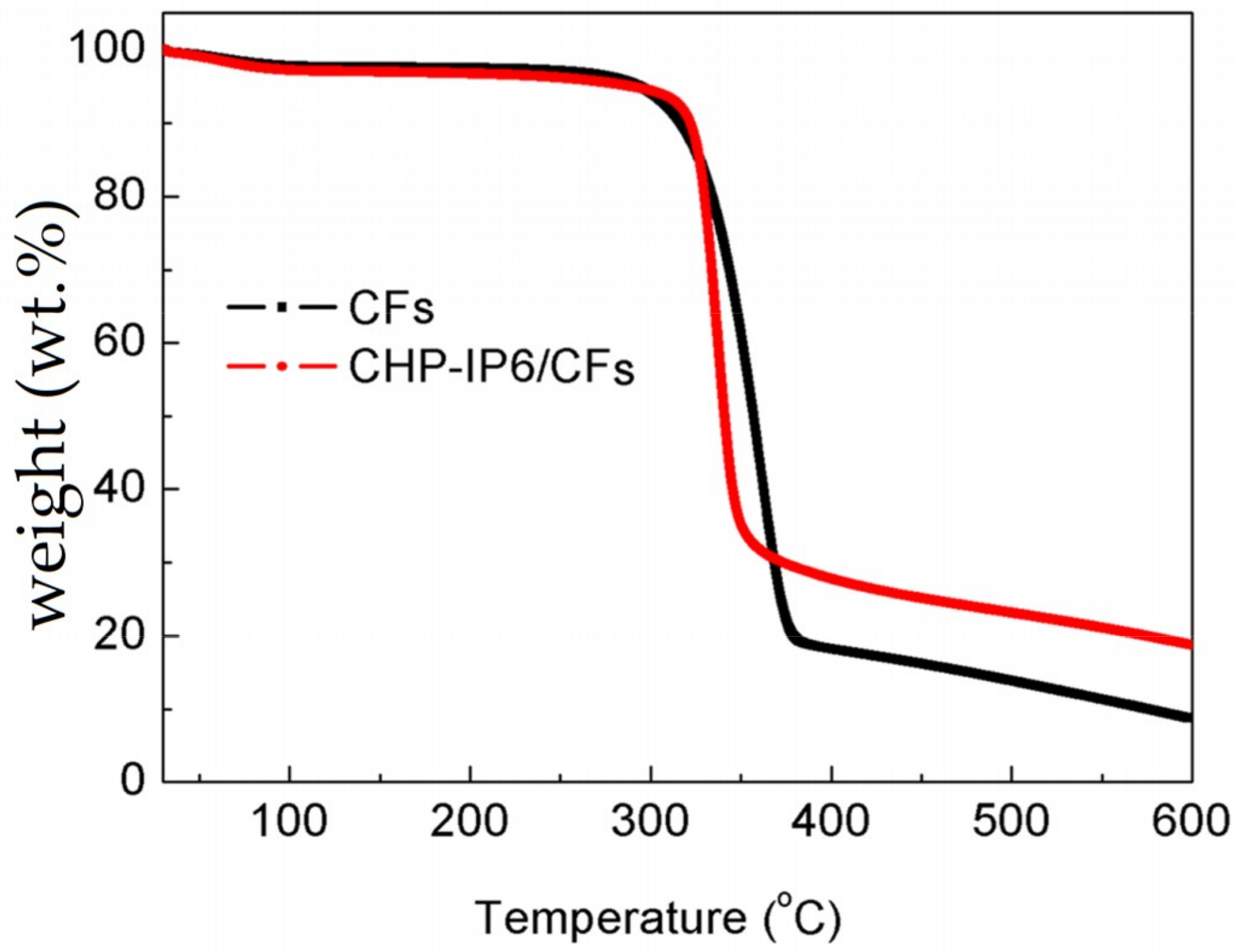
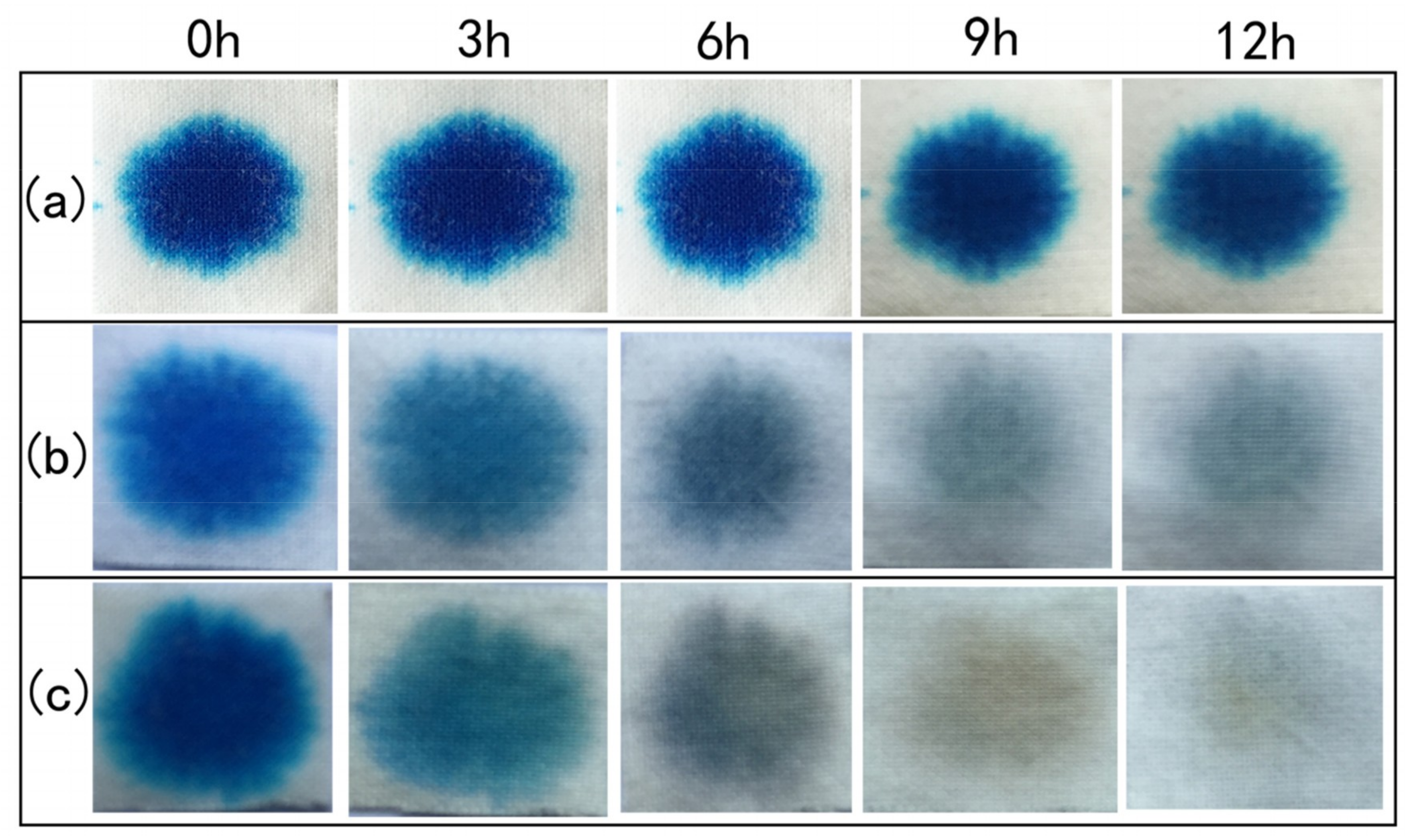
© 2019 by the authors. Licensee MDPI, Basel, Switzerland. This article is an open access article distributed under the terms and conditions of the Creative Commons Attribution (CC BY) license (http://creativecommons.org/licenses/by/4.0/).
Share and Cite
Gao, D.; Wang, L.; Wang, C.; Chen, T. Photocatalytic Self-Cleaning Cotton Fabrics Coated by Cu2(OH)PO4 under VIS/NIR Irradiation. Materials 2019, 12, 238. https://doi.org/10.3390/ma12020238
Gao D, Wang L, Wang C, Chen T. Photocatalytic Self-Cleaning Cotton Fabrics Coated by Cu2(OH)PO4 under VIS/NIR Irradiation. Materials. 2019; 12(2):238. https://doi.org/10.3390/ma12020238
Chicago/Turabian StyleGao, Dawei, Lili Wang, Chunxia Wang, and Tan Chen. 2019. "Photocatalytic Self-Cleaning Cotton Fabrics Coated by Cu2(OH)PO4 under VIS/NIR Irradiation" Materials 12, no. 2: 238. https://doi.org/10.3390/ma12020238
APA StyleGao, D., Wang, L., Wang, C., & Chen, T. (2019). Photocatalytic Self-Cleaning Cotton Fabrics Coated by Cu2(OH)PO4 under VIS/NIR Irradiation. Materials, 12(2), 238. https://doi.org/10.3390/ma12020238



